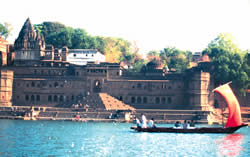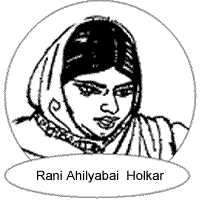
Dimdima
Online Children's Magazine from India

Dimdima
Online Children's Magazine from India

Maheshwar is an ancient city on the banks of the Narmada. People have been living there since the beginning of the second millennium B.C. It saw glorious times when it was the capital of the Kalachuri king, Kartivir Arjun. Then it lay in obscurity until the 18th century, when Rani Ahilyabai Holkar of the Holkar dynasty made it the capital of her kingdom.
 Ahilyabai Holkar married Khanderao Holkar, the son of Maharaja Malharrao Holkar of Indore in 1734. when she was just nine years old. As Khanderao lived a life of pleasure and indulged in vices, Malharrao trained Ahilyabai in the affairs of the state. She even accompained him to the battlefield.
Ahilyabai Holkar married Khanderao Holkar, the son of Maharaja Malharrao Holkar of Indore in 1734. when she was just nine years old. As Khanderao lived a life of pleasure and indulged in vices, Malharrao trained Ahilyabai in the affairs of the state. She even accompained him to the battlefield.
Ahilyabai ascended the throne after the death of her son, Malerao in 1767.In the three decades of her rule, she established peace and prosperity in the kingdom. Art and literature flourished. She opened free kitchens at places of pilgrimage and also constructed temples, dharamshalas and bathing ghats.
She also introduced the weaving of the famous Maheshwari saris, by bringing weavers from Mandu and neighbouring Gujarat to teach the trade to her people. Maheshwari saris are famous for their sheer lightness, fine quality and simple, yet unique borders. The trade is being kept alive by some of Ahilyabai’s ancestors today.
Muharram is celebrated in a grand manner in Maheshwar. Tazias of various sizes - some as high as three-storeyed buildings, are carried in procession to the banks of the Narmada. Children dressed in colourful clothes squat along the roadside as they wait to watch the tazias pass by.
The tazias are lined on the banks of the Narmada. Water from the river is sprinkled on them, and then they are taken by boats to the centre of the river, where they are immersed amidst loud chantings of ‘Yah Hassan, Yah Hussain’.
As the Narmada leaves Maheshwar, one can see Sati memorials on either sides of her banks. These are stone statues that have been erected in memory of the women who perished on the funeral pyres of their husbands.
Last updated on :12/5/2005
Dimdima is the Sanskrit word for ‘drumbeat’. In olden days, victory in battle was heralded by the beat of drums or any important news to be conveyed to the people used to be accompanied with drumbeats.
Bharatiya Vidya Bhavan
K. M Munshi Marg,
Chowpatty, Mumbai - 400 007
email : editor@dimdima.com
Bharatiya Vidya Bhavan
505, Sane Guruji Marg,
Tardeo, Mumbai - 400 034
email : promo@dimdima.com
Dimdima.com, the Children's Website of Bharatiya Vidya Bhavan launched in 2000 and came out with a Printed version of Dimdima Magazine in 2004. At present the Printed Version have more than 35,000 subscribers from India and Abroad.